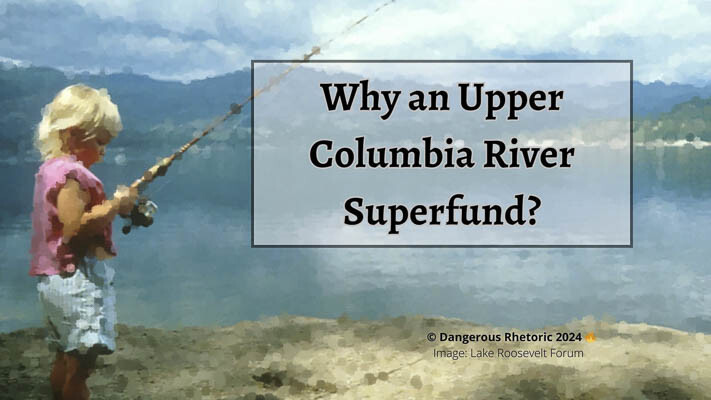
This article is the first of a series that will explore this issue, and provide information and understanding of the Upper Columbia River so that all stakeholders can effectively participate in the process
Nancy Churchill
Dangerous Rhetoric
In a surprise move, the Environmental Protection Agency has proposed designating the upper Columbia River a superfund cleanup site on the National Priorities List or NPL. This proposed massive site would stretch from the Grand Coulee Dam all the way to the Canadian Border. This is a 150-mile river reach that includes Lake Roosevelt and about 77,000 acres of land south of the border in Stevens County called the “uplands.”

On March 7, the EPA published a Federal Register notice which started a 60-day public comment period from March 7 to May 6, 2024. NPL listing is a two-step process. First, sites are proposed to the NPL. Then, after public comment is received and reviewed, a second Federal Register notice is required to formally place a site on the NPL.
This article is the first of a series which will explore this very complex issue, and provide readers the information and understanding of the Upper Columbia River so that all stakeholders can effectively participate in the process, providing public comment on the proposal during the 60-day public comment period.
A legacy of mining
The northeast corner of Washington is a traditional mining district, and former mining and smelting operations polluted portions of the upper Columbia both from effluence discharged directly into the river and by smokestacks. Primary pollutants were lead, arsenic and some other heavy metals.
According to an EPA Press Release “In 2006 the EPA and Teck Metals Ltd, entered into a settlement agreement along with Teck American Inc. and the US Department of Justice to complete studies that establish the nature and extent of contamination.” That was 18 years ago, and these studies are still in progress. Teck America has done a significant amount of remediation during that time.
The EPA’s proposed Superfund designation was prompted by concerns about improper disposal of hazardous materials that, according to the EPA, tested at higher than acceptable levels. The current proposal is specifically based on assessments that suggest elevated levels of lead and arsenic levels are posing a risk to residents’ health.
Is there a risk to health?
The health risk assessment completed in 2021 shows “unacceptable risks to people’s health caused primarily by lead…” However, the EPA has only recently changed it’s residential soil lead guidance. Information provided to a local health advisory board indicated that this recent change in the lead standard invalidated older tests that had been done on residents in the uplands area of Stevens County. Those blood tests used the previous, less stringent testing level for exposure. At this time, it appears that there is not any actual test data that supports the EPA’s assessments of increased health risk.
There are heavy metals in the river bed, mostly in the deepest parts of the river. Fortunately, this problem is solved naturally, as these metals get encapsulated by silt during spring runoff and are gradually being buried deep in the river bottom sediment. Disturbing the sediment in a misguided effort to “clean” the river bottom would only stir up and release these heavy metals into the main flow of the river.
In addition, the water in Lake Roosevelt, according to the EPA, meets drinking water standards. The fish caught in Lake Roosevelt are safe to eat. Lake Roosevelt is a popular recreational lake managed by the National Park Service, with camping, fishing, swimming, and all types of recreational boating opportunities. If this lake was hazardous to human health, wouldn’t the public already be complaining about this? They’re not complaining, because there’s not a significant threat to human health. A lack of transparency and stakeholder participation
Like the recent agreement between the U.S. government and the “Six Sovereigns” about the Lower Snake River Dams, the recent proposal from the EPA was only approved by Governor Inslee, and representatives from the Colville Tribes and the Spokane Tribes, whose reservations are bordered by Lake Roosevelt. However, all the other stakeholders in the region were left out of the negotiations with the EPA and the flow of information supporting the listing.
Stakeholders and community members have raised concerns about the testing and investigation methods used by the EPA throughout this process. The lack of concrete evidence of contamination in certain areas, including Lincoln County and most of Stevens County, has created unnecessary fear and alarm that could cause a steep decline in the value of property and agricultural products in the region.
Mark Matava, a spokesman for Rep. Cathy McMorris Rodgers, said “Our office is closely monitoring concerns regarding the EPA’s proposal to designate the upper Columbia River Basin as a Superfund site. While the congresswoman recognizes the importance of addressing potential contamination, she has serious concerns about what this listing would mean for the region. She is actively engaging with the EPA and community members to ensure transparency in this process as next steps are determined to protect the environment as well as people’s health and safety.”
A transfer of wealth and property rights
Superfund rules allow the EPA a great deal of latitude both in defining the original area and in expanding that area. During the duration of the superfund designation, use of the area may be significantly curtailed and property rights severely limited. Property values will certainly be greatly lowered, which will hurt property owners and the local governments that depend on those properties for funding schools and local government. There will also be a massive transfer of wealth from the U.S. taxpayers into the pockets of the mitigation industry and environmental groups who are incentivized to keep the money flowing as long as possible.
In future columns, we’ll look more closely at the EPA Superfund rules, how to make comments on the proposal, and at the very complex social, health and environmental issues at stake in the upper Columbia River area.
Nancy Churchill is a writer and educator in rural eastern Washington state, and the state committeewoman for the Ferry County Republican Party. She may be reached at DangerousRhetoric@pm.me. The opinions expressed in Dangerous Rhetoric are her own. Dangerous Rhetoric is available on thinkspot, Rumble and Substack.
Also read:
- Letter: ‘We’re going to give them some money and a plane ticket, and then we’re going to work with them’Camas resident Anna Miller supports a new structured self-deportation policy, calling it a balanced approach to immigration and economic needs.
- Opinion: What the 2025 legislature tells us about why Washington’s government keeps failingTodd Myers of the Washington Policy Center argues that Washington’s government fails because it resists humility, experimentation, and accountability in its policymaking.
- Letter: Vancouver needs broader leadership than just a teacher’s lensVancouver resident Peter Bracchi urges Mayor Anne McEnerny-Ogle not to seek another term, calling for more diverse and inclusive leadership rooted in broader experiences.
- Opinion: Legislative session ‘was full of ups and downs and many learning experiences’Rep. John Ley reflects on the 2025 legislative session, highlighting local funding victories and warning of major tax increases passed by the majority.
- Opinion: Washington state Legislature 2025: That’s a wrapElizabeth New (Hovde) of the Washington Policy Center breaks down the highlights and lowlights of Washington’s 2025 legislative session, warning of rising taxes and new mandates.










